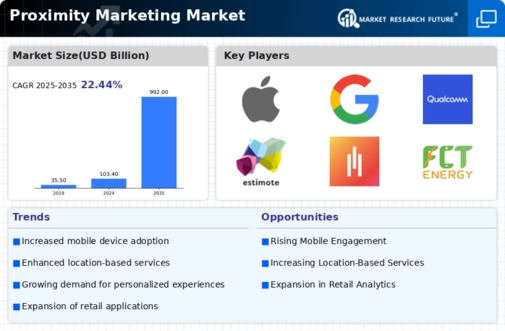Top Industry Leaders in the Proximity Marketing Market

Competitive Landscape of Proximity Marketing Market:
This dynamic landscape is home to a diverse array of players vying for market share, each employing unique strategies to captivate consumers in the physical realm. Understanding the competitive dynamics is crucial for brands and investors alike, as navigating this terrain can lead to lucrative opportunities.
Key Players:
- Apple Inc.
- Google Inc.
- Microsoft Corporation
- Qualcomm Inc.
- Zebra Technologies Corporation
- Bluvision Inc.
- Estimote Inc.
- inMarket Media LLC
- Proxama PLC
- PROXIMITY
- SFC Energy AG
- FC TecNrgy
- Osram
- Avnet
- Gautier Semences
Strategies Adopted:
- Specialization vs. Diversification:Some players focus on specific technologies like beacons or NFC, while others offer a broader suite of solutions encompassing software, hardware, and analytics. The choice depends on factors like target market and existing capabilities.
- Data-Driven Insights:Leveraging customer behavior data collected through proximity interactions is key to delivering personalized experiences and optimizing campaign performance. Players are investing heavily in analytics platforms to gain actionable insights.
- Partnerships and Integrations:Collaborations with other players in the ecosystem, such as platform providers and retailers, expand reach and offer comprehensive solutions to clients.
- Focus on Privacy and Security:Building trust with consumers through transparent data practices and robust security measures is crucial in a privacy-conscious market.
Factors for Market Share Analysis:
- Technology Portfolio:The breadth and depth of a player's technology offerings, including hardware, software, and analytics capabilities, influence market share.
- Client Base and Industry Focus:The size and profile of a player's client base, particularly in key verticals like retail, hospitality, and healthcare, affect market share.
- Geographical Reach:A global presence and strong regional partnerships can give players a significant edge in the market.
- Innovation and R&D:Continuously developing new technologies and features that enhance user experience and campaign effectiveness is crucial for maintaining market share.
New and Emerging Companies:
- Proximity-as-a-Service (PaaS) Providers:Startups like Gimbal and PlaceIQ offer PaaS solutions, allowing businesses to leverage proximity marketing without significant upfront investment.
- Location-Based AR/VR Platforms:Companies like Niantic and Blippar are integrating proximity marketing with AR/VR experiences, creating immersive and interactive customer engagements.
- Hyperlocal Marketing Platforms:Players like Urban Airship and Airship focus on delivering hyper-targeted promotions and content based on real-time location data, catering to the growing demand for micro-targeting.
Current Company Investment Trends:
- Integration with IoT and AI:Players are actively integrating proximity marketing solutions with IoT platforms and AI-powered analytics to personalize experiences and optimize campaign performance in real-time.
- Focus on Omnichannel Marketing:Integrating proximity marketing with other channels like social media and email marketing is gaining traction, creating a holistic customer journey.
- Beacon Technology Advancement:Development of long-range beacons and integration with Bluetooth Low Energy (BLE) 5.0 are opening up new possibilities for location-based interactions.
- Privacy-Preserving Technologies:Players are investing in technologies like federated learning and differential privacy to ensure data security and user trust.
Latest Company Updates:
October 26, 2023: Google announced the launch of Nearby Share for Web, enabling users to share files directly between web browsers and nearby Android devices.
November 15, 2023: Apple updated its iBeacon API with improved accuracy and support for new beacon formats.
December 12, 2023: Proximity Marketing World 2023 conference took place in London, gathering industry leaders to discuss the latest trends and innovations.









